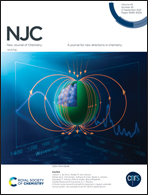2D Z-scheme TiO2/SnS2 heterojunctions with enhanced visible-light photocatalytic performance for refractory contaminants and mechanistic insights†
Abstract
In this work, a two-dimensional (2D) TiO2/SnS2 nanosheet heterojunction with a novel face-to-face structure was fabricated by a two-step hydrothermal method. The morphology, microstructure, chemical components, as well as optical features, photocatalytic activity, photoelectrochemical (PEC) performance and catalytic mechanism of TiO2/SnS2 were systematically investigated. The results indicate that the 2D TiO2/SnS2 sheet-like heterojunction can enhance the photocatalytic activity for refractory contaminants including methyl orange (MO), methylene blue (MB), rhodamine B (RhB), and tetracycline antibiotics (TCs). TiO2/SnS2 with a mole ratio of Sn : Ti = 0.15 : 1 possesses the best photocatalytic activity and PEC performance. The corresponding photocurrent density (∼3.79 μA cm−2) is 3.4 and 2.6 times higher than those of TiO2 (∼1.11 μA cm−2) and SnS2 (∼1.45 μA cm−2). Enhanced photocatalytic activity and PEC performance are ascribed to the synergistic effect of TiO2/SnS2 heterostructures, including (i) Z-scheme band alignments, which can effectively inhibit photogenerated carrier recombination, (ii) modulation of narrow band SnS2, which can broaden the visible photoabsorption region, and (iii) face-to-face structures, which can provide a convenient transport channel for photoinduced carriers.



 Please wait while we load your content...
Please wait while we load your content...